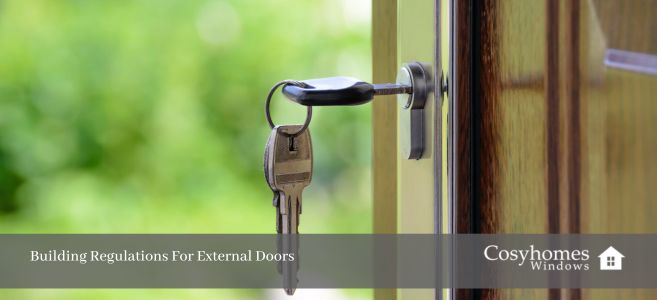When thinking of replacing an exterior door, it’s important to be familiar with the building regulations for external doors. You will need to adhere to these regulations with your replacement doors, which include fire safety, energy efficiency, and accessibility.
Fire Safety Regulations for External Doors
A very important part to consider when installing new exterior doors is fire safety. If this door will be a fire safe door, it must comply with building regulations. The door must:
- have an unobstructed area of at least 0.33m2 and at least 450mm high and wide.
- have a step no larger than 15mm.
- have a clear opening of 775mm.
The main purpose of a fire door is to contain a fire and stop it from spreading. If your external door is a communal door or for doors in public buildings, for example, it must be fire-rated and sufficiently robust. In your home, it’s not likely that you will need to install an external fire door. Instead, this door would be an external exit door, like your front door. However, fire doors are a good choice for safety with a new door.
If your fire safety door contains glass, it must contain safety glazing that has been specially designed to protect against fire.
Thermal Performance Regulations for External Doors
Thermal insulation is essential for energy-efficient external doors as they prevent heat transfer between the inside and outside. A material’s thermal performance is measured by something called U-values, with lower values indicating better insulation. Meeting or surpassing minimum U-value requirements for external doors is needed for energy efficiency, as it helps to reduce heat loss and ensure compliance with current building regulations.
Accessibility Regulations for External Doors
External doors need to meet current accessibility standards, including a minimum width for wheelchair access and user-friendly opening mechanisms, such as accessible handles. By being fully compliant and ensuring easy disabled access, you’re ensuring inclusivity and easy navigation for those with additional mobility needs.
Compliance and Enforcement of Building Regulations
To gain building regulations approval for external doors you must submit plans to your local authority for approval. Non-compliance may lead to a fine and even legal action, which is why it is so important to adhere to standards to avoid penalties and ensure a safe environment.
Depending on the style of the building and your new door, you may need to seek planning or building inspectors’ permission to replace exterior windows and doors. This would apply if you are replacing the door in a listed building or live in a conservation area. If neither of these apply, it’s unlikely that you will need any approved documents or a building control officer to approve your windows and doors.
Conclusion
It is vital to work with qualified and experienced professionals when replacing external doors, to ensure that you comply with building regulations. Including safety, energy efficiency, and adequate accessibility.
If you are unsure or would like more expert advice, don’t hesitate to contact Cosyhomes Windows.


















No Response to "Building Regulations For External Doors"